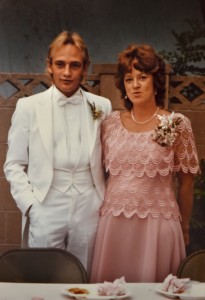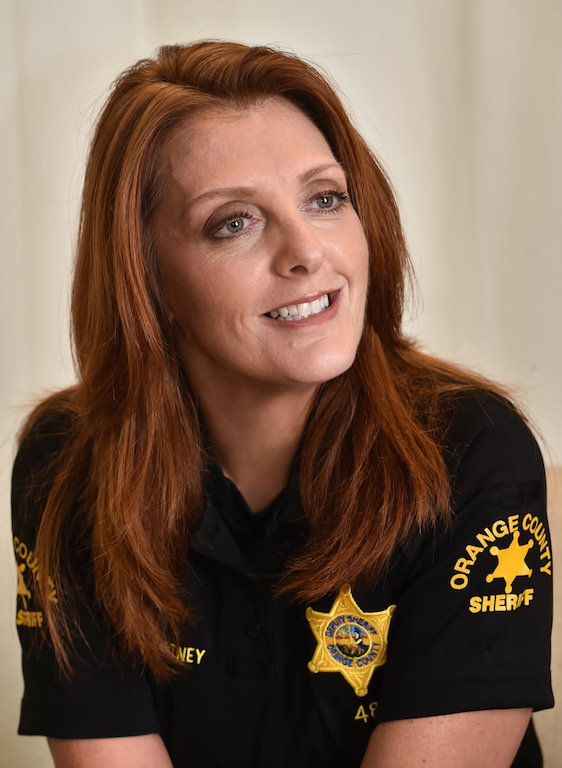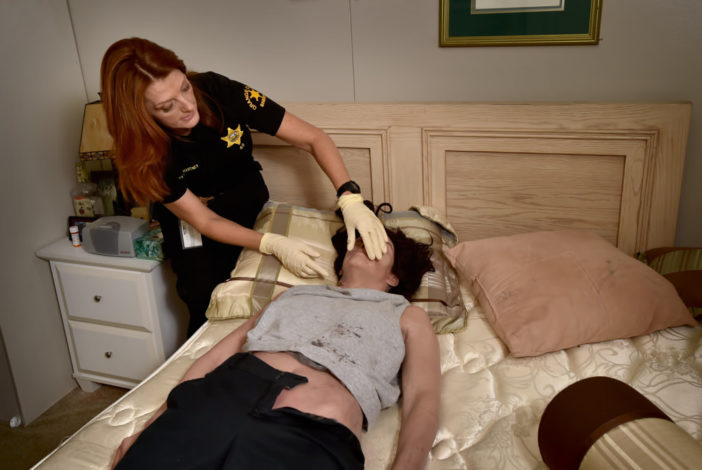On every call, she starts at the head and works her way down, careful not to miss anything.
Did the decedent suffer any trauma, and if so, where and what kind?
What was the approximate time of death?
Any tattoos or other distinctive body markings?
As an Orange County Sheriff’s Department deputy coroner investigator who responds to death scenes — from traffic accidents to unattended deaths in homes, to babies who pass away unexpectedly to homicides and freeway jumpers —- Michelle Hartney deals in hard, cold and disturbing facts.
And her job is to quickly get answers —- not just for her unit within the OCSD, but, just as critically, for bereaved loved ones.
So it’s quite the irony that what inspired Hartney, in part, to pursue her emotionally trying and arduous profession is a tragedy that, more than 27 years, still has not been fully answered:
The shooting death, on Nov. 11, 1989, of Hartney’s older brother outside an Anaheim bar after closing time.
GIRLY SPACE
Hartney’s desk inside the Coroner’s Division of the OCSD in Santa Ana is a study in stark contrasts.
There’s a tube of lipstick next to a death certificate.
Files of some of her 40 or so cases still pending are stacked near a stapler blinged out in pink, along with a matching tape dispenser.
“Considering the job I do,” says Hartney, 48, “at least I can be girly at my desk.”
Hartney, who modeled in her late teens and was an extra on the movie “The Karen Carpenter Story,” regularly enters scenes most people would find unimaginable.
One of her first coroner calls was when she went on a ridealong years before she got hired by the OCSD.
A child had suffered an accidental and traumatic death. The boy, around 8, was on his bike when he got his pants stuck in the chain.
As he bent over to untangle his pants at an intersection, the light turned green and a driver of a semi, not seeing him, ran over him.
“There were tire tracks across his face,” Hartney recalls.

Michelle Hartney has been a deputy coroner investigator for 11 years.
Photo by Steven Georges/Behind the Badge OC
LEAN TEAM
Hartney is one of the OCSD’s 18 deputy coroner investigators.
The unit, which also has five supervisors, is very lean.
In a county of more than 3 million residents, Hartney and her colleagues provide 24/7 coverage. In 2016 alone, OCSD deputy coroner investigators went into the field 1,888 times and handled a total of more than 7,900 cases (most are done over the phone).
“These guys work very hard and do a phenomenal job each and every day,” said Rod Thomas, Coroner Investigations Manager. “I’m very proud of the work they do.”
It’s work Hartney initially became fascinated with as a child growing up in Fullerton.
Whenever “Quincy,” the Jack Klugman-starring coroner and police procedural, aired, Hartney was glued to the boob tube.
An animal lover, she would act out of compassion and pull dead pets off the road whenever she happened upon them.
“I was never bothered by the blood and guts,” Hartney says.
DEATH OUTSIDE OF A BAR
Hartney was horrified and distraught, however, when her half-brother from New Zealand, William Charles Bevan Purdy, 31, died of a gunshot to the back of his head after a night of drinking with his best friend and his friend’s brother.
The bullet entered the base of his neck.
Hartney was 20 at the time.
“I was pretty devastated,” she says.
Hartney was 10 years old when she found out she had two half-siblings from her birth parents, who both are from Auckland, New Zealand. She was raised an only child in Orange County by her biological mother and step-father.
Purdy came to the United States when Hartney was 10 and lived with her and her parents for a while.
The two became close.
After last call at Foxy’s, Purdy and his two companions were outside and in a kind of huddle when the gun went off. The .25-caliber weapon belonged to Purdy and had been strapped in a holster on his waist.
A mechanic for a car dealership, Purdy was married at the time but was having marital problems.
He had a history of drug and alcohol abuse and, according to coroner documents, previously had expressed suicidal thoughts to loved ones.
Toxicology reports show Purdy had a blood-alcohol level of .30 when he died.
But investigators did not end up with enough evidence to say one way or another if Purdy’s death was accidental, a suicide or homicide.
Officially, his death was classified as “undetermined.”

William Purdy, Michelle Hartney’s half-brother, with Hartney’s mother, Annette, taken at William’s wedding in 1988. Photo courtesy of Hartney
LONG TIME COMING
Hartney’s realization of becoming a deputy coroner investigator for the OCSD took a long time — four interviews stretching over a decade.
Her brother’s death, and that ridealong with the coroner, helped fuel her desire to work in forensics.
Initially wanting to become a veterinarian while attending Sunny Hills High School in Fullerton, Hartney ended up majoring in criminal justice at Cal State Fullerton, with a minor in forensics.
But for years, Hartney worked as an escrow assistant at a real estate company while preparing for her dream job.
The first time she applied to become an OCSD deputy coroner investigator, Hartney was told she needed more forensics-related education.
So she took several POST (Peace Officer Standards and Training) classes and EMT courses and applied again, only to fail to make the cut.
“Getting this job was never about money,” Hartney says. “It’s really what I wanted to do.”
The third time Hartney made it far in the process, only to be disappointed again. So to make her stand out from other future applicants, she put herself — at age 32 — through the Los Angeles County Sheriff’s Department academy.
“I felt like their mom,” Hartney says of her academy classmates.
A groin injury deep into academy training, however, forced Hartney to pull out.
She finally got hired by the OCSD as a civil technician, a non-sworn position in which she served lawsuits and eviction notices.
Only four months into that job, Hartney saw an internal listing for a deputy coroner investigator and applied.
This time, at age 36, Hartney nailed it.

Michelle Hartney: “I love when I can provide answers to families. It’s very rewarding.” Photo by Steven Georges/Behind the Badge OC
A BADGE AND A GUN
Deputy coroner investigators are sworn deputies with full police powers. At death scenes, they are the head honchos.
“We have a big responsibility,” says Hartney.
When she responds to death scenes, Hartney shows up with her badge and gun.
She is part of a team of professionals, from beat cops to the medical doctors who perform autopsies, who work hard to untangle the mysteries of death — the how, who, what and why of it.
As a deputy coroner investigator, Hartney has to determine if a death is questionable or suspicious based on the scene and evidence, and then make the necessary calls to handle the scene appropriately.
She also shows up with her “rollout bag,” a suitcase that’s nothing like those lugged around by tourists.
Gunshot residue evidence kit.
Toe tags.
A spray specifically designed to neutralize the smell of a dead human body.
These are among the several items in Hartney’s rollout bag.
She talks about her job in one of three “scenario rooms” the OC Coroner uses for training.
Each room contains an amazingly lifelike “corpse” whose cause and manner of death is determined by aspiring deputy coroner investigators.
The OCSD Coroner training facility is considered to be one of the most advanced in the nation.
“He’s a decomp (for decomposition),” Hartney explains of a “deceased” latex dummy. “See how he’s bloated? A person could probably get to this condition in four to seven days with the heat cranked up. Definitely.”
Hartney’s had a busy day.
“I was out in the rain,” she says. “A guy hung himself in his backyard. We were slammed today. We had a traffic (fatality), we had a jumper.”
Around the coroner’s office, Hartney is known for her soft touch.
“I would say that Michelle has a knack, or maybe better described as a skill, as it relates to dealing with grieving and mournful family members during the worst times of their lives,” Thomas said.
“She’s very compassionate and empathetic and is capable, even in some of the most emotional of cases, to calm family members down and assure them that we have their loved one’s best interest in mind with the aim of providing (the families) the services that they require in their hour of need,” Thomas added.
Divorced and with no children, Hartney says connecting with families is the most rewarding part of her job.
She relates how the mother of a young man who died of a heroin overdose at first was standoffish and uncooperative.

Michelle Hartney, a senior deputy coroner investigator for the OCSD, with a fake corpse used for training purposes.
Photo by Steven Georges/Behind the Badge OC
A few months later, Hartney — who still is working the case — has become friends with the woman.
“She even wrote a commendation letter for me,” Hartney says.
Hartney says her nose is “burned out” so the smells on death calls don’t bother her.
Some things do, though.
“I can’t do vomit,” she says.
But at the end of the day, when she goes home, she’s able to shut things off. She loves to go stand-up paddle-boarding and to hike and run, and she also loves to travel.
Hartney says she’s not trying to get her brother’s case solved.
But she, like the families she deals with every day at work, someday would like more closure.
“I’ve been on the other side of things, so to some degree I know what the families I deal with are going through,” Hartney says. “I never got all the answers in my brother’s death, but I love when I can provide answers to families. It’s very rewarding.”
 Behind the Badge
Behind the Badge




